Ata-ul-Haye Nasir, Ahmadiyya Archive & Research Centre
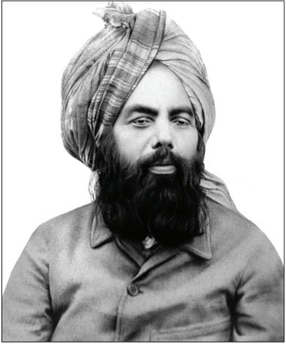
The need for the Imam
Hazrat Mirza Ghulam Ahmadas of Qadian was appointed by Allah Almighty as the Promised Messiah to revive Islam and unite mankind under the flag of the Holy Prophet Muhammadsa. In an era when materialism was on the rise, Islam was facing challenges from all sides, and the Muslims had also deviated from the true teachings of Islam, Hazrat Ahmadas entered the spiritual battlefield as the true defender of Islam. He emphasised the need for humanity to adhere to the true Islamic teachings of upholding the rights of God Almighty and His creation.
Hazrat Ahmadas said:
“In this age, the world is brimming with disagreements. The Jews say one thing, whereas the Christians profess another and aside from this, the ummah of Muhammadsa is mired in internal conflicts. Meanwhile, the idolaters present their opinions against all of the others. So many new religions and beliefs have arisen that everyone seems to be practising their own unique brand of religion. Therefore, in conformity with the established practice of Allah, it was essential that a hakam [arbiter] should have come to settle all of these disputes. Hence, that very hakam was bestowed the titles ‘the Promised Messiah’ and ‘the Blessed Mahdi’, meaning that he was deemed to be the Messiah on account of resolving external disputes and he was proclaimed the destined Mahdi on account of settling the internal conflicts.” (The Philosophy of Divine Revelation [Haqiqatul Wahi], p. 57)
A divine vision
Narrating a divine vision, the Promised Messiahas stated:
“I saw that I was standing on a pulpit in the city of London and was setting forth the truth of Islam in the English language, in a very well-reasoned address. Thereafter, I caught several birds who were sitting upon small trees and were of white colour and their bodies resembled the bodies of partridges. I interpreted this to mean that though I would not [be able to travel to that country], my writings will reach those people and many righteous English people will be attracted to the truth.” (Izala-e-Auham, Ruhani Khazain, Vol. 3, p. 377)

During his lifetime, the Promised Messiah’sas writings, claims and prophecies had reached far and wide through various periodicals, including those of the Community.
Ahmadiyya periodicals serving the Promised Messiah’sas mission
Mentioning the claims and teachings of the Promised Messiahas under the title “A New Prophet in Islam”, The Madras Weekly Mail wrote:
“Ghulam Ahmad[as] keeps up a printing press and a book depot. He publishes two rather wide-awake papers, Al Hakam in Urdu, and The Review of Religions, in English.” (The Madras Weekly Mail, 22 October 1903, p. 18)

Hazrat Mufti Muhammad Sadiqra states that the Promised Messiahas used to say:
“These newspapers, Al Hakam and Badr, are my two ‘arms’. They immediately publish the revelations to [other] countries and become witnesses.” (Zikr-e-Habib, p. 151)
Barahin-e-Ahmadiyya
Barahin-e-Ahmadiyya was the first book written by the Promised Messiahas – the first volume of which was published in 1880 – in which he established the truth of Islam and also narrated several prophecies after receiving glad tidings from Allah the Almighty.
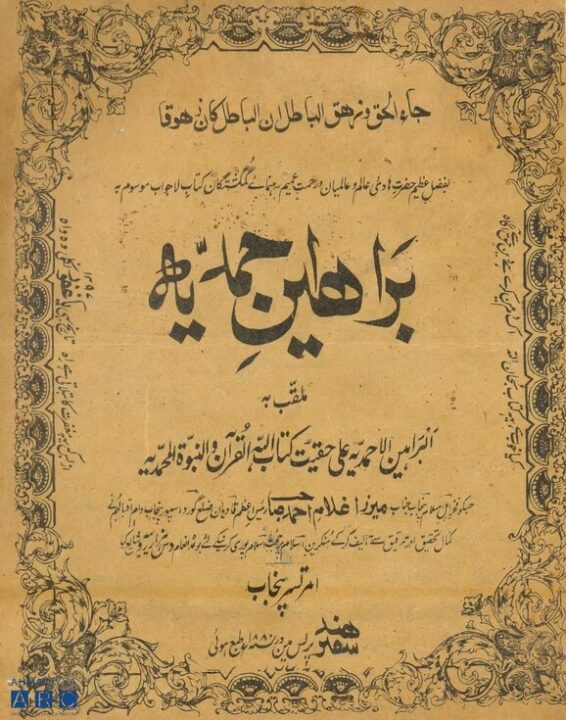
In regards to Barahin-e-Ahmadiyya, The Times of India wrote:
It is “a striking sign of the times that a Mahomedan (Mirza Gulam Ahmed, Chief of Kadian, District Gurdaspur, Punjab,) should throw down the gauntlet to prove to the world that the ‘only true and only revealed religion by means of which one might know God to be free from blemish, and obtain a strong conviction as to the perfection of His attributes is the religion of Islam’ […]. His arguments are contained in a compilation euphoniously entitled ‘Burahin-i-Ahmadia,’ which, if anyone will undertake to refute, the author offers to give him a reward of Rs. 10,000. The Mirza claims to be inspired, and modestly asserts that his virtues bear a very close similarity and strict analogy to those of Jesus Christ. He further goes on to say in his manifesto, that all those who […] will not become earnest enquirers after the truth, with himself as the medium of course, shall be answerable to God, and he finishes up with the following prayer, which I produce here in extenso:
“‘Oh gracious God! guide the pliable hearts of all the nations, so that they may have faith on Thy chosen Prophet [Best of the Messengers] Muhammad [Mustafa, peace and blessings of Allah be upon him] and on Thy [Perfect and] Holy Al-Quran, and that they may follow the commandments contained therein, so that they may thus be benefited by the peace and true happiness which are specially enjoyed by the true Moslems in both the worlds, and may obtain absolution and eternal life, which is not only procurable in the next world, but is also enjoyed by the truthful and honest people even in this world, especially the English nation, who have not as yet availed themselves of the sunshine of truth […]. O God! guide them and help them with Thy grace, and instil in their minds the love for Thy religion, and attract them with Thy power, so that they may have faith in Thy book and prophet, and embrace Thy religion in groups. Amen! [summa] amen!’ [Majmu‘ah-e-Ishtiharat [1989], Vol. 1, p. 25]” (The Times of India, 3 March 1885, p. 5)
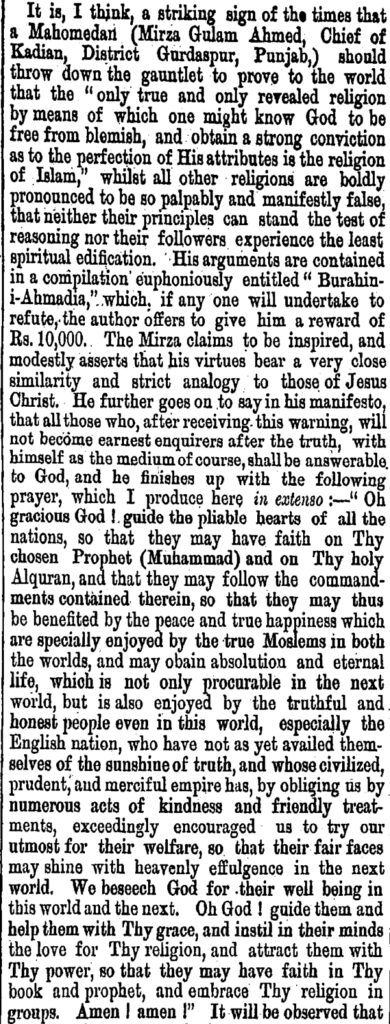
Invitation to witness the truth
Hazrat Ahmadas propagated his claims through books, letters, and pamphlets. Moreover, in 1885, he sent 8,000 copies of registered letters in English to the religious leaders, rulers, scholars, and thinkers of Asia, Europe, and America, informing them of his claim, and inviting them to come and witness the truthfulness of Islam at Qadian. He stated that if a sign was not witnessed within a year, a sum of 200 rupees per month would be paid as compensation to such an individual. (Majmu‘ah-e-Ishtiharat [1989], Vol. 1, pp. 20-22)
Propagation of the Promised Messiah’sas message through various periodicals
The Toronto Daily Mail reported under the heading “To Convert Bradlaugh”:
“Mr Charles Bradlaugh, the famous infidel, who is always elected as a member of Parliament for Northampton, and always rejected by the House, has now an opportunity of getting converted, and of making handsome wages during the process. The offer comes from Prince Mirza Gholam Ahmed, C.I.E., an Indian potentate of fabulous wealth, and a Mohammedan of great proselytising zeal. The Prince has read Mr Bradlaugh’s works sympathetically, and believes that with a proper course of teaching by Moslem sages, he would become a bright and shining light of Islamism. The Prince proposes, therefore, that Mr Bradlaugh shall come to the former’s domains in the Punjab, and shall put himself under tuition with a view to his conversion. The Prince agrees to furnish the neophyte with a suitable palace and a retinue of servants, to provide for all his household expenditures, which shall be on a scale of magnificence consistent with the honour due to a Prince’s guest, and to furnish him an allowance of 200 rupees per month during the entire process of conversion. Mr Bradlaugh is said to be seriously considering the invitation, although he says that the task of getting converted would probably be a life-long job.” (The Toronto Daily Mail, 5 June 1885, p. 1)

The Civil and Military Gazette wrote that Hazrat Mirza Ghulam Ahmadas “has caused a great religious sensation in the Punjab,” and “is said to be a man of very high attainments. He is also the author of numerous works on religion, and among his followers is a hakeem [Hazrat Hakim Maulvi Nuruddinra] of Jammu, another very learned man, who places implicit confidence in the revelation which” Hazrat Ahmadas “professes to receive from God.” (The Civil and Military Gazette, 6 February 1892, p. 3)

The New York Times wrote under the heading “East Indian Wants to Prove Mohammed’s Greatness”:
“A curious proposition has been made to Lord Curzon of Kedleston, the Viceroy of India, by Mirza Ahmad, a well-known Mohammedan of Kadian. He wants the British Government to call a public conference of all the religions and submit them to competitive examination under two demonstrations of the sublimity of their moral teachings and an outward sign of Divine support by the performance within a year of some miracle transcending all human limits.” (The New York Times, 3 December 1899, p. 7)
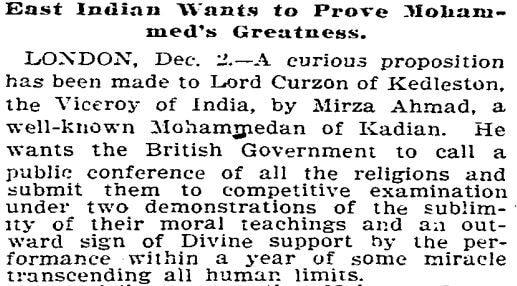
The Tribune of Lahore, on 8 December 1900, wrote that Hazrat Mirza Ghulam Ahmadas “sees visions, and receives, as he asserts, direct inspiration,” and he “is no doubt a remarkable personality.”
The annual report of the Punjab Religious Book Society (1901) stated:
“The Western education and thought profoundly modifying Muslim religious conceptions is sufficiently shown by the existence of the Anglo-Muhammadan College at Aligarh (North-West Provinces) and the influential sect of Necharis (believers in natural law-rationalists) which follows the late Sir Sayyad Ahmad Khan, and includes such men as Mr Justice Amir Ali. It is interesting to notice that, as in Hinduism, the more westernised and progressive Brahmo Samaj has been followed here by the more conservative reform of the Arya Samaj, so in Islam, the Punjab has given us a new Islamic reformer of more conservative tendencies than Sir Sayyad Ahmad, yet whose followers differ materially from orthodox Islam in their attitude towards Western thought, while like the Arya Samaj, they are among the most determined and systematic opponents of Christianity. The person to whom I refer is Mirza Ghulam Ahmad of the village of Qadian, near Batala. This man claims to be an inspired restorer of the decaying faith of Islam. […] His literary gifts and persuasive personality and mastery of intrigue have secured him a considerable following, among whom are some able men.” (The Civil and Military Gazette, 1 May 1902, p. 8)

Claims and prophecies of the Promised Messiahas
The oldest evening paper of London, The Globe, wrote:
“Mirza Ghulam Ahmad, of India, describing himself as a Messiah, has challenged the prophet Dowie of Chicago to a duel, the weapons to be invocations to Providence. Each man is to pray that ‘whoever of us two is the liar may perish first.’” (The Globe, 14 July 1903, p. 1)

The Evening Chronicle of Newcastle wrote:
“A New Messiah
“Remarkable Document
“Within the past few weeks, there has been issued from Qadian, in the Punjab, a Notice ‘for circulation in Europe and America,’ entitled ‘Predictions Concerning Pigott and Dowie. By the Promised Messiah.’ This remarkable document, which forms a six-page pamphlet, has (says the Glasgow Herald’s London correspondent) been printed at Lahore in the English language, but the Promised Messiah is apparently a native of Asia, since the pamphlet includes a Translator’s Note, and the signature appended to the Predictions is Mirza Ghulam Ahmad.
“The ‘Delusion’ of Christianity
“It may be of interest to indicate, briefly and without comment, the contents of the Notice. There is no ambiguity about the statement of the claim put forward. Mirza Ghulam Ahmad categorically affirms – ‘I am the true Messiah who was to come in the last ages.’ But his idea of the nature of the Messiah differs materially from the orthodox Christian conception. ‘It is impossible,’ he declares, ‘that a man should ever become God, but he can attain to the highest degree of connection with Him, and is thus made an image of the Divine Being. … The delusion under which labours the Christian sect, which takes Jesus for God, is stronger than the delusion of all other people who have ever been the dupes of similar errors;’ and what Mirza Ghulam Ahmad finds particularly disappointing in connection with Christian religion, is that when ‘the false dogma’ is found to be ‘unacceptable to the growing intellect of the age, new methods are devised to renew a belief in the absurd theory, and new false claims are set up to uphold old ones.’
“As might be expected from the title of the pamphlet, the claims that call for the strongest condemnation from Mirza Ghulam Ahmad are those put forward by Mr Dowie and Mr Pigott.
“‘Hundreds of Heavenly Signs’
“It is because the earth is defiled with impieties and impure doctrines and false claims, Mirza Ghulam Ahmad declares, that the true Messiah has been raised up in his person in the land of the Punjab. Though he makes no pretence of being himself divine, yet ‘I do not claim to be the Promised Messiah simply by my own assertion. … The evidence of God has been manifested in hundreds of heavenly signs shown in my support. I say it truly that Almighty God has poured His grace upon me in far greater abundance than upon the Messiah who has gone before me. In the looking-glass of my person the face of God is revealed to a far greater extent than in that of Jesus’s person. If those are simply my own assertions, and there is no other authority for them, I am a liar; but if Almighty God bears witness to my truth, no one can give the lie to me.” (The Evening Chronicle, 27 October 1903, p. 4)

The Courier of Dundee wrote:
“An Exultant Prophet – A curious booklet comes from Mirza Ghulam Ahmad, of Qadian, India. He calls himself ‘the promised Messiah,’ and says that, incensed at the imposture of the Prophet Dowie, he challenged him ‘to pray that of us two whoever is the liar may perish first.’ Dowie declined, and the Indian gentleman prophesied his death. Dowie died, and his challenger, blandly accepting the responsibility of ‘praying’ him to death, issues a fourteen-page booklet on the matter.” (The Courier of Dundee, 27 May 1907, p. 8)
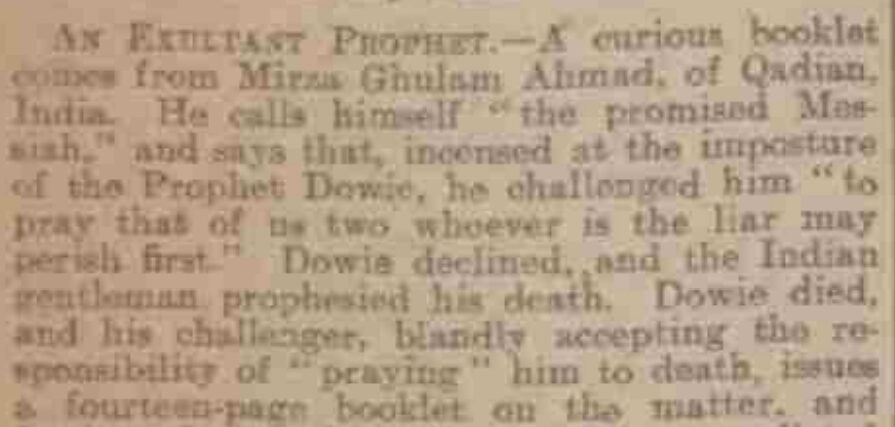
The Register of Adelaide wrote under the title “A Mohammedan Prophet”:
“Reprinted in pamphlet form, an extract from the April number of The Review of Religions, Qadian Gurdaspur, India, states that Mirza Ghulam Ahmad, ‘the Promised Messiah,’ has realized a prophecy of ‘divine judgment in Dowie’s death.’ Quite a number of American and European newspapers are mentioned as having printed in 1903 a remarkable forecast by ‘the Promised Messiah,’ that the modern Elijah would ‘leave the world before my eyes with great sorrow and torment,’ and that ‘calamity will certainly overtake his city.’ At that time Ahmad was 70 years of age, and Dowie was about 55, and healthy and prosperous with his enterprise. The pathetic circumstances of Dowie’s last days and the financial troubles of Zion are narrated as evidence of the fulfilment ‘of this grand prophecy.’ Ahmad puts other prophecies to his credit – punishment by earthquake and plague. ‘Thou, O Europe, are not safe, nor thou, O Asia! And ye that dwell in islands; no self-made deity will assist you in that day. I see cities falling down, and I find inhabited places in ruin.’ Ahmad asserts that the result of his predictions are such as to ‘distinguish the true messenger of God from a false claimant.’” (The Register, 3 June 1907, p. 6)
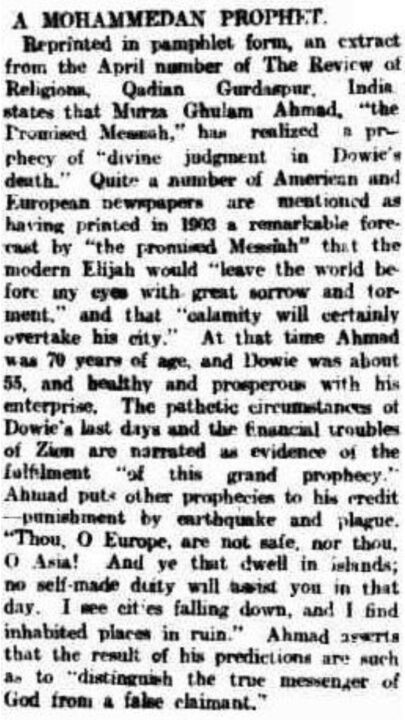
The Millom Gazette of England wrote under the title “From the Mysterious East”:
“The latest claim is on behalf of a Moslem prophet named Ghulam Mirza Ahmad, who (we gather from some mysterious literature forwarded to us from India, says ‘The Star,’ by the gentleman’s son and successor, Mirza Bashir-ud-Din Mahmud Ahmad) flourished about 25 years ago. (At least, we hope he flourished; he was an exceptional prophet if he didn’t). He called himself the Promised Messiah, founded the Ahmadiyya Movement, Quadian, and predicted (so his son claims) the death of Dr Dowie, the rise of Japan, the overthrow of the Shah, the amendment of the partition of Bengal, and the late Balkan War.
“This is the alleged prediction of the present war which Ahmad wrote in 1906:
“’The days are near, nay, they are at the door, when the world shall see an unparalleled scene of devastation. Not only will great earthquakes come, but other calamities from heaven and earth will also visit the earth. … Thou, O Europe! Art not safe, nor thou, O Asia! And ye that dwell in islands! No self-made deity will assist you on that day. I see cities falling down and I find inhabited places in ruin.’ [Haqiqatul Wahi, Ruhani Khazain, Vol. 22, pp. 268-269]
“Ahmad’s Achievement
“Ahmad added that ‘had I not come, these calamities would have been put off for a while, but with my appearance, the secret designs of the wrath of God have been made manifest.’ [Ibid, p. 268].” (The Millom Gazette, 20 November 1914, p. 6)

In August 1915, Hassan Musa Khan Sahib, an Ahmadi missionary in Australia, sent a letter to the Truth of New Zealand, along with a copy of the April 1907 issue of The Review of Religions which included an article on the Promised Messiah’sas prophecy about Dr Dowie and its grand fulfilment. The Truth published the letter in its 18 September 1915 issue, on page 12, titled “An Indian Messiah”.
On 23 October 1915, the Truth wrote:
“Indian Messiah Ahmad
“The Mahomedan Tolstoy’s Teachings
“The Author of Eighty Literary Works
“Explains His Moral and Religious Tenets
“The Indian Messiah as Prophet, Literateur and Lecturer
“In a previous issue [18 September 1915] we gave some account of remarkable prophecies, regarding Dowie, the alleged ‘Elijah’ and other impostors, made by one Mirza Ghulam Ahmad. We published the prophecies at the request of one of our Indian readers, in Queensland, H Musa Khan. This same correspondent has sent us some further information about this remarkable man Ahmad. It appears that there are very many natives of India who look upon Ahmad as a true prophet […]. Ahmad does appear to have believed himself to be the Messiah expected by the Jews and other religious teachers. This belief did not include an acceptance of the teachings of those who believe that the Messiah was to be more than man. The predicted Messiah was, according to Ahmad, to be a great Deliverer and Saviour of the people, but not one who was divine, although he might be divinely inspired.” (Truth, 23 October 1915, p. 12)
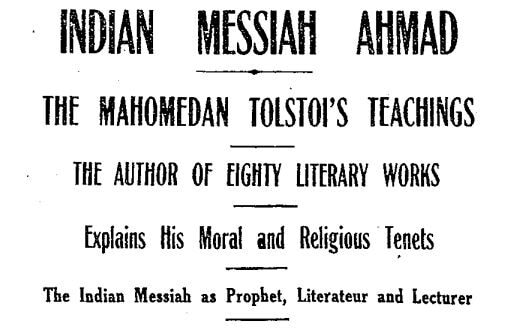
Echoing the Promised Messiah’sas claim about the death of Jesusas
In 1916, an Irish author named George Moore wrote a book called “The Brook Kerith”, which was based on the idea that Jesusas did not die on the cross, but survived and eventually travelled to India. In its review, The Birmingham Daily Post wrote:
“Mr George Moore may or may not have heard of the Prophet of Quadian, but if the career, teaching, and disputations of that […] Sheikh are unknown to Mr Moore, there are some Anglican bishops and missionaries of comparatively recent experience in Upper India to whom they are not unknown. For these Mr Moore’s latest book holds no surprises; if they read it at all. ‘The Brook Kerith’ must inevitably suggest to them ‘Quadian’. […] The Prophet of Quadian was also a serious person, and he told us a great deal more than Mr Moore – ‘greatly daring,’ as the critics say – has ventured to set down. […] The Sheikh of Quadian […] preached, he ran a newspaper, and he wrote pamphlets mainly to prove that Jesus of Nazareth did not die on the Cross, that he was taken down alive by Joseph of Arimathea, and that he lived to a great old age.” (The Birmingham Daily Post, 6 September 1916, p. 3)

Propagation of the Holy Quran’s true understanding by the Promised Messiahas and his Khulafa
Allah the Almighty states in the Holy Quran:
اِنَّا نَحۡنُ نَزَّلۡنَا الذِّكۡرَ وَاِنَّا لَهٗ لَحٰفِظُوۡنَ
“Verily, We Ourself have sent down this Exhortation, and most surely We will be its Guardian.” (Surah al-Hijr, Ch. 15: V. 10)
Commenting on this, the Promised Messiahas said:
“This foretells that there will be a time when Islam will pass through a troubling time, be confronted by severe opposition and a huge turmoil will erupt. At that time, its remedy would be provided by God Almighty Himself, and He would provide an ‘ark’ to save [mankind] from that ‘storm’. That ‘ark’ is the mission [da‘wah] of this humble self.” (Aina-e-Kamalat-e-Islam, Ruhani Khazain, Vol. 5, footnote, p. 264)
Alluding to this, Hazrat Musleh-e-Maudra said:
“In this era, when the people have become extremely negligent about their faith, Allah the Almighty has sent the ma’mur [appointed one] who has purified the commentaries of the Holy Quran from the unnecessary and doubtful points, and presented them to the world in their true form. […] In short, God Almighty has not based the spiritual guardianship of the Holy Quran on [human] reason, and its interpretation does not rely on human reason alone, but rather, He has taken the responsibility to guard it through His own Word.” (Tafsir-e-Kabir, Vol. 4, p. 20)
The Promised Messiahas brought a true understanding of the Holy Quran to the world, dispelling the false notions and inferences that had led Muslims astray. After him, his Khulafa are continuing his mission and propagating the true teachings of Islam and the Holy Quran. Under the divine guidance of Khilafat-e-Ahmadiyya, the Jamaat has translated the Holy Quran into various languages of the world.
On one occasion, mentioning the services of Ahmadiyyat in regards to the Holy Quran’s translation into different languages, Hazrat Musleh-e-Maudra said that Allah has decreed all of these blessings for us and its fulfilment is due to the blessings of Khilafat:
“We had the opportunity to accomplish the task that the strongest of the [Muslim] kings could not do. […] This is the blessing of Khilafat and unity, which has enabled the Jamaat to publish the Holy Quran’s translation into various languages.” (Khitabat-e-Shura, Vol. 3, p. 600)
In 1915, the first part of the English translation of the Holy Quran with explanatory notes was published, which was based on the commentary by Hazrat Khalifatul Masih IIra.
A review by The Civil and Military Gazette stated:
“We have received from Qadian the first part of a new edition of ‘The Holy Quran,’ with English translation and explanatory notes. This edition is being published under the auspices of Hazrat Mirza Bashir-ud-Din Mahmud Ahmad, the second successor of the Promised Messiah, by the Anjuman-i-Taraqqi-i-Islam, Qadian, Punjab. […] Without expressing an opinion as to the adequacy of the translation or the accuracy of the notes, we can confidently state that an enormous amount of labour has been expended upon the work and that the setting of the translation in the matter of type and printing is worthy of the great subject.” (The Civil and Military Gazette, 10 August 1916, p. 8)

The Harvard Theological Review of October 1917 and The Jewish Herald of 15 December 1916 also published reviews on this.
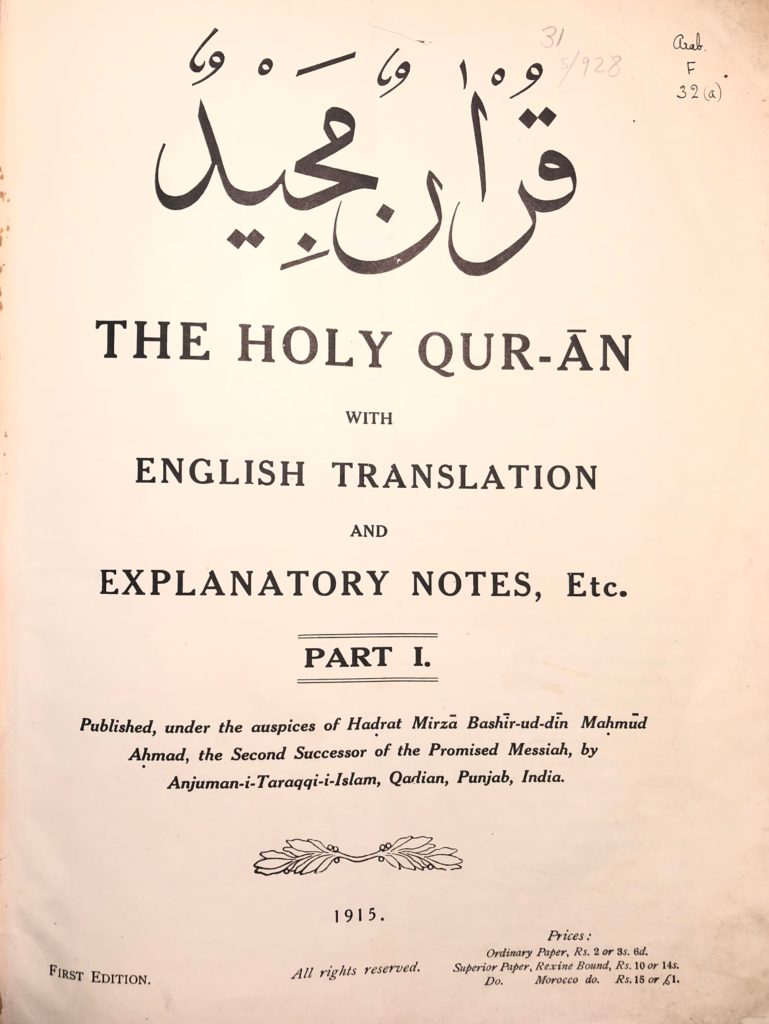
The Promised Messiah’sas mission to unite mankind under the flag of Islam
The Promised Messiahas states:
“Let it be clear that my advent in the present age is not for the reformation of the Muslims alone, but I have come to reform the people of all the three religions: Muslims, Christians and Hindus. Just as God has appointed me the Promised Messiah for the Muslims and Christians, so am I the Avatar for the Hindus. For the past twenty years or so, I have been proclaiming that just as I have appeared in the spirit of the Messiah son of Maryas for the purpose of removing sins which have filled the earth, so have I come as Raja Krishna—one of the greatest Avatars of the Hindu faith. In other words, I am the same person by virtue of spiritual reality. This is no fancy or speculation on my part. The God of heaven and earth has revealed to me, not once but a number of times, that for the Hindus I am Krishna and for the Muslims and Christians I am the Promised Messiah.” (Lecture Sialkot, pp. 38-39)
This mission of the Promised Messiahas is continuing through Khilafat-e-Ahmadiyya, which is propagating the true teachings of Islam all around the world. To achieve this objective, Ahmadiyya missions have been established all around the world, which are serving to propagate the Promised Messiah’sas message far and wide and bringing pious souls under the flag of the Holy Prophet Muhammadsa.
In 1926, The Evening Chronicle of Newcastle mentioned the missionary efforts of the Ahmadiyya Muslim Jamaat under the title “Islam Invades the States, Missionary Force to be Reckoned with, Christianity Menaced?”:
“Mary Caroline Holmes writes in ‘The Moslem World’, a magazine devoted to Christian missionary work among the Moslems, it is not orthodox Islam which has become missionary in character, but a movement within Islam which originated in India 35 years ago. Mirza Ghulam Ahmed, whose ancestors were Turkish, believed he had a special mission to bring about a regeneration of Hindus, Mohammedans and Christians. For the Mohammedans and Christians, he was the Christ, he believed; for the Hindus an avatar, or incarnation, of Krishna.” (The Evening Chronicle, 4 August 1926, p. 7)

The Lewisham Borough News of England wrote in 1945:
“The Ahmadiyya Movement is a purely religious movement within Islam and was founded 56 years ago by the Prophet Ahmad, who claimed to have come ‘in the power and spirit’ of Jesus.
“The Holy Founder of the Movement died in 1908 and was succeeded by his principal disciple, who was selected by the Community as Successor to the Founder. The First Successor died in March 1914, and the present Head of the Movement was elected to succeed him.
“The Movement has spread rapidly in many parts of the world, notably in India, the Dutch East Indies and the British Colonies of West Africa. It maintains Missions in many parts of the world, including the USA and Great Britain.
“A Mosque was built by the Ahmadiyya Community at 63, Melrose Road, Southfields, London, SW18, twenty years ago, and a Mission House is attached to the Mosque.” (Lewisham Borough News, 2 October 1945, p. 4)

In 1948, Hazrat Musleh-e-Maudra instructed Malik Ataur Rahman Sahib – a missionary serving in France at the time – to visit Belgium. He visited Brussels and Antwerp and was interviewed by several newspapers of Belgium, including Le Phare Dimanche. It states:
[Translation]
“Islam Invades Europe!
“Islam, a religion of continuous transformation, has always produced a number of prophets. Some of them creating schisms and sects, which exist up to now, others having disappeared without leaving a trace.
“A few days ago, a little man, with intelligent eyes and a lowered gaze, presented himself as the representative of the ‘Messiah’ at the Phare Dimanche.
“According [to him] a Messiah has appeared in India (where he died in 1908) and has instructed his disciples to spread his message to the corners of the world. This is how, without the help of the sword, Muslims are trying to convert Christians to [the faith of] the Quran! This is, to say the least, a new and original [endeavour].
“According to this envoy (‘Amir’ of the Ahmadiyyah movement), the prophet Hazrat Ahmad is the Messiah. It was prophesied that the Messiah would be of tanned complexion and would have straight hair (as did Hazrat Ahmad). The prophecy says that he would have a twin sister; he would be born in a village named Kad’a; he would stammer slightly and would suffer from two ailments: all these signs were fulfilled in Hazrat Ahmad.
“He is ‘Krishna’ and ‘Buddha’ for the Hindus, ‘Mesio’ for the Zoroastrians, ‘Messiah’ for the Christians and ‘Mahdi’ for the Muslims. How can one ever doubt this? How can one ever doubt the fulfilment of the prophecy that ‘the whole world, in the end, will accept Islam’?
“According to the ‘Amir’, the Ahmadiyyah movement has established communities everywhere in the world, even in the United States, the United Kingdom and France. He wants to establish one at least in Belgium.
“What else can [we] do but to wish good luck to this man? Are not all beliefs worthy [of our] respect?” (Le Phare Dimanche, 19 December 1948)

The Ministry of USA, a periodical for the Ministerial Seventh-Day Adventists, wrote:
“Many of the readers of this journal will find the word Ahmadiyat a new one to them […]. Spelled variously as Ahmadiyat, Ahmadiyyat, or Ahmediyyat, the term signifies the religious movement founded in the late nineteenth century by Mirza Ghulam Ahmad of Qadian, in Northern India. Its world headquarters today is at Rabwah, in West Pakistan. It was intended to be a revivalist movement within Islam, not only to call Moslems back to what Mirza Ghulam Ahmad considered was pristine Islam but also to challenge both Christianity and Hinduism to defend their positions, or more appropriately, to leave their apostate religions in exchange for what the Ahmadi founder believed to be the ‘true’ Islam.” (The Ministry, March 1967, p. 20)

We are living in the blessed era of Hazrat Khalifatul Masih Vaa who is continuing the mission of the Promised Messiahas and propagating the true teachings of Islam to the corners of the world. The Jamaat of the Promised Messiahas is flourishing, by the grace of Allah, and leaping forward to new heights.
Just recently, on 30 September 2022, Hazrat Khalifatul Masih Vaa inaugurated the Fath-e-Azeem in Zion, USA, which is one of the many signs of the Promised Messiah’sas truthfulness.
During his Friday Sermon on 30 September 2022, while inaugurating the Fath-e-Azeem Mosque, Huzooraa quoted the article of The Sunday Herald of Boston, dated 23 June 1907, which included an introduction to the Promised Messiah’sas claim and the challenge he had issued to Dowie. The article titled “Great is Mirza Ghulam Ahmad The Messiah – Foretold pathetic end of Dowie, and now he predicts plague, flood and earthquake”.
After mentioning this article, Hazrat Khalifatul Masih Vaa said:
“Indeed, this was a victory and a testament to the truthfulness of the Promised Messiahas. However, as I have mentioned, the mission of the Promised Messiahas is very vast and this is just the mention of a victory on one front. We will find true happiness and joy only when we bring the entire world into the subservience of the Holy Prophetsa. To achieve this, we must seek out new avenues of propagating Islam alongside the construction of this mosque. We must present the arguments of the Messiah of Muhammadsa to the world. More so than ever, we must improve our actions and spiritual states. […] Thus, we must give continuity to the victory attained by the Promised Messiahas into the future by propagating Islam and through prayers. […] The Muslims started to face decline only when the world became more important to them; their standards of righteousness began to fall and their regard for worship continued to decrease. However, because it was the promise of Allah the Almighty to the Holy Prophetsa that this religion would remain established and will be granted strength until the Day of Judgement, He sent the Promised Messiah and Mahdias in the latter days. After his advent, the Promised Messiahas informed the world of his coming and despite not having sufficient means, his message reached Europe and America and many other countries.” (Al Hakam, 28 October 2022, Issue 241, p. 16)


Amazing, comprehensive, fantastic! Painstakingly researched and fully referenced! Thank you!